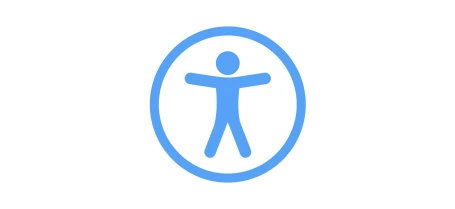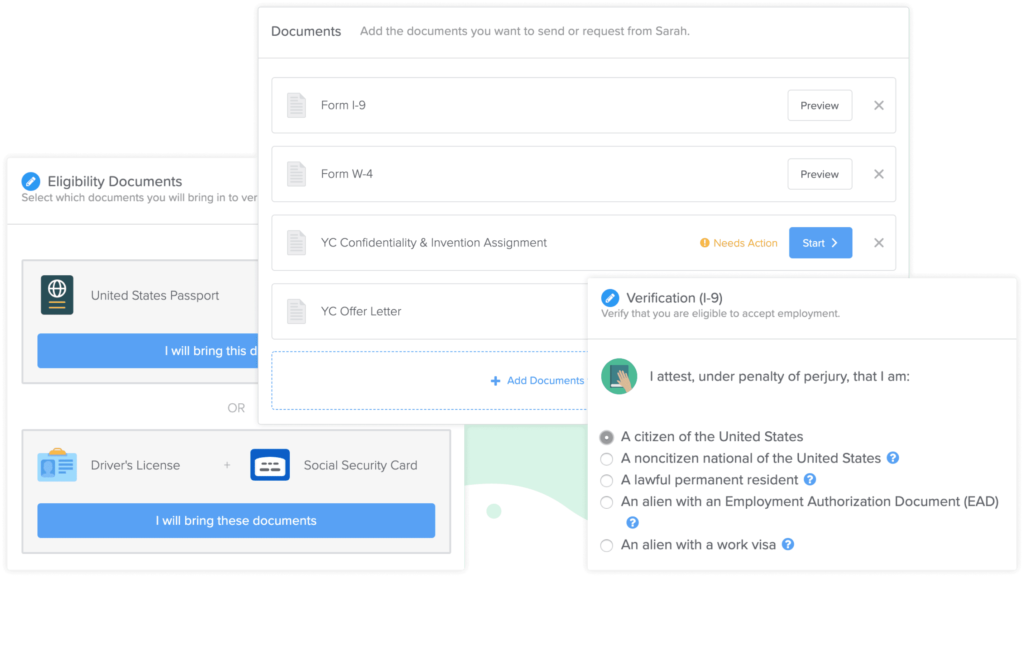15 Tips for Onboarding Employees with Disabilities and Differences
An inclusive onboarding experience can set the right tone for the employee’s new role.
by Aimie Ye - June 23rd, 2021
Creating an inclusive workplace begins in the hiring process. Candidates and new hires with disabilities (e.g., visual impairment, deafness, intellectual disability) or differences (e.g., neurodivergence, autism, transgender or gender non-conforming employees in the workplace) not only may need accommodations to perform their job duties but may also require assistance to complete the application, go through the interview, and successfully complete the onboarding phase.
Download the Free DEI Policy Template
Think of inclusivity as the next step of diversity. Whether you’re supporting transgender employees in the workplace or employing someone with a physical disability, inclusivity is all about creating a welcoming environment for every employee and setting them up for success.
To learn more about how HR can create inclusivity from the very start of the employee experience, we asked 15 HR experts what they’re doing in their organizations that other companies should do, too. Here’s what they had to say:
Don’t Rely Solely on Written Onboarding Materials
“Offer training and materials in multiple mediums, such as written, visual, and even audio formats. One of our new hires was dyslexic and struggled with the written paperwork, which is why we switched to multiple formats. Another great idea for making your onboarding process more open, which came in handy for us during COVID when everyone was working from home, is creating a virtual office tour. It gives them a chance to learn the office layout and meet team members without too much pressure.” - Janelle Owens, HR Director at Test Prep Insight
Write Clear Employee Handbook Policies
“Employers should have a policy in their employee handbook that instructs employees to contact HR if they require accommodations to perform their job's essential functions. A policy in the employee handbook indicating that the organization does not retaliate against employees who request accommodations should also be included. These are excellent, baseline practices because companies can establish that employees were informed of their right to request accommodations as well as how to request them in the event of a lawsuit.” - Timothy Robinson, CEO at inVPN
Don’t Skimp on Training for Supervisors and Managers
“It's vital to train front-line managers and supervisors—those in charge of dealing with employees on a daily basis—to recognize when an employee requests accommodation and what to do about it. These supervisors and managers frequently lack even rudimentary ADA training, and they will be unsure what to do if they come into an ADA-triggering event. They might think an employee is whining or requesting special treatment. Instead, HR may choose to escalate the situation so that it can participate in the interactive process appropriately and quickly.” - Thilo Huellmann, CTO at Levity.ai
Get Help with Auditing Processes and Onboarding Policies
“If you are unsure about how to build ADA compliance into your onboarding process, the best thing you can do is to speak to a disability access consultant. They are affordable and can vastly improve processes that might be lacking.” - Markus Albert, Managing Director at EatFirst
Ensure Job Descriptions Accurately Reflect Job Responsibilities
“Employee expectations can be established through job descriptions, which also serve as a benchmark for what employers must or must not accommodate. Job descriptions, when correctly designed and kept up-to-date, can be an HR professional's best friend during the interaction process. If they don't, they can become an employer's worst enemy during a lawsuit. When the job changes in a significant way or on a yearly basis, job descriptions should be updated. ” - Darshan Somashekar, Founder & CEO at Solitaired
Managers and Coworkers Can Provide Additional On-the-Job Flexibility
“Flexibility on the job can mean holding inclusive meetings that allow people with various communication styles to participate, providing extended feedback periods for major decisions, and allowing employees to work how and where they want.” - Charles McMillan, Founder at Stand With Main Street
Communicate in Advance
“One practice we’ve adopted to accommodate neurodivergent employees is to be intentional about giving at least a month's notice for any special events, outings, or otherwise non-normative workdays. While being spontaneous or surprising employees can be fun, it can also be tough for neurodivergent individuals who value having a predictable daily schedule.” - Daivat Dholakia at Force By Mojio
Understand the Pain Points Related to Specific Disabilities or Differences
“Accommodation tools like screen readers are not always perfect solutions. For example, screen readers do a lot of the heavy lifting when it comes to things like forms and informational packets, but HR needs to do a thorough job in making forms and packets more screen reader-friendly. Include a descriptive ALT text for all images used, make form fields larger and in contrasting colors, and break up blocks of text. Also, we’ve found that offering flexible hours and the ability to opt out of things like the use of cameras in Zoom meetings (or meetings altogether) allow our neurodivergent employees the chance to do their work around their needs rather than having to conform to ours. If you’re unsure of how to approach this, consult with a representative who can help determine accommodations based on the ADA guidelines. If possible, consult with the individuals themselves to gain their perspective, too.” - Dan Bailey, President at WikiLawn
Go Straight to the Source
“Asking employees, ‘What do you need from us to assist you to do your job?’ is a great way to open up the conversation and get honest, first-hand insight.” - Chris Nutbeen, Founder & CEO of Nuttifox
Prepare for an Inclusive Experience Before Day 1
“Go through your PowerPoint presentations and training modules and ensure they are captioned before the employee’s first day. Also, run an awareness training session for your existing employees beforehand. It’ll help avoid disability or difference terminology and etiquette issues and ensure everyone feels confident regarding employee interactions.” - Magda Klimkiewicz, HR Business Partner at Zety
Set the Right Expectations Early
“We start by introducing the new hires with norms of the company. We inform them of the rules and policies so that they remain compliant with the organization.” - Harriet Chan at CocoFinder
Partner New Hires with an Online Mentor
“To make onboarding even better for staff who have disabilities, I recommend providing them with an online mentor. By pairing the new staff member with someone who is available online, it reduces the barriers to access to a mentor and still keeps the personalization (rather than just a voice on the other end of a telephone, for example). The digital mentor can act not only to provide advice and support in relation to the work role, company culture, and other questions but can also help the new employee to solve accessibility issues such as physical access to a building. Some basic training for the mentor in basic ADA/DDA considerations might also be useful.” - Dr. Valeria Lo Iacono, Owner at Symonds Research
Offer Multiple Modes of Communication
“HR can make employee onboarding more accessible for employees with disabilities by offering information in multiple modes of communication. For example, for those with difficulty in hearing, subtitling your videos can be a great way to put information across without sacrificing clarity.” - John Li, Co-Founder & CTO at Fig Loans
Examine Your Current Infrastructure
“Access sets the tone for the new employee’s ongoing experience. Here’s a quick rundown of things you can look for:
Is your place easily reachable?
Do you have handicapped parking?
Can everyone access the website and online forms?
Are print materials in an accessible format (e.g., large print, Braille, text file)?
How does parking and building access look and function (e.g., keyless entrance, security concerns, bathrooms, break rooms, and workout areas)?
Do you offer computer and communication technology accessibility (e.g., alternative input devices, screen reading software, screen magnification, telephone amplification, smartphone or tablet apps)?
Do you offer services or work-related help (e.g., sign language translators, readers, note-takers)?
Are emergency evacuation and shelter-in-place plans accessible?
How else can you modify the workplace (e.g., furniture, lighting, space, noise reduction)?
To begin, ensure that your company has the infrastructure in place to assist and accommodate persons with disabilities in the workplace. The ADA provides a checklist to assist you in evaluating your institution.” - Olivia Tan, Co-Founder at CocoFax
Anticipate Their Needs and Get Everyone Involved
“When you are onboarding new hires with special needs, the best person to tell you what they require is the employee. Ask them to tell you how you can help them. This way, you can plan accordingly and provide them with the custom-tailored content they need instead of just trying to guess their expectations. You may also anticipate some of their needs, such as adding closed captions for all training videos or enabling text-to-speech. You could even design a new version of your training courses for a specific disability, such as visual impairment (refer to ADA guidelines to stay compliant). Don’t skip the training altogether just because of special needs. Document the training and any adaptations to track their completion. Above all else, make sure you prepare your team. Train your staff so they understand how to treat someone who is differently-abled. Depending on the disability, they might try to learn basic sign language or make a conscious effort to speak slowly and face-to-face.” -Planm8.io
Are you supporting transgender employees in the workplace by using the employees’ preferred pronouns with no questions asked? Does your onboarding include the use of multiple formats to support disabilities, such as visual impairment or deafness? Reviewing your onboarding processes is an important step toward creating an inclusive workplace for individuals with differences and disabilities. Put the above tips into practice and let inclusivity become your new competitive advantage.
Search...
Product
GoCo
Resources
Articles
eBooks
Webinars
Customer Stories

